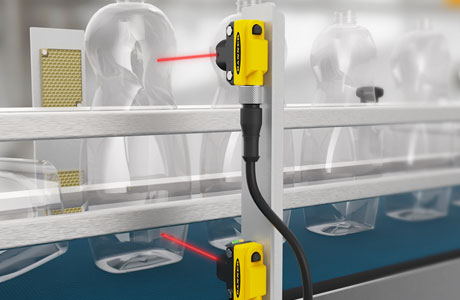Key Takeaway
A photoelectric sensor works by using light to detect objects. It has an emitter that sends out a light beam and a receiver that detects the light. When an object interrupts or reflects the beam, the sensor notices the change and triggers an electrical signal. This simple principle makes photoelectric sensors effective for detecting objects in many industrial applications.
The sensor’s performance depends on the type of light used—infrared, visible, or laser—and the object’s surface, like its color and reflectivity. Different types of sensors (through-beam, retroreflective, or diffuse) offer various detection ranges and precision levels, making them versatile across industries.
The Basic Principle of Operation Behind Photoelectric Sensors
At its core, a photoelectric sensor works by detecting light. When an object enters the sensor’s detection zone, it either blocks or reflects a beam of light, depending on the type of sensor. This triggers a change in the signal, which the sensor interprets to perform its designated task, such as opening a door or counting items on a conveyor belt.
These sensors are highly sensitive to changes in light intensity. The emitter, often a light source like an LED or laser, sends out a light beam. When this beam is interrupted or reflected, the sensor detects the change, allowing the system to respond accordingly. Simple, yet highly effective. It’s a principle that applies across countless industries, making photoelectric sensors an essential part of many automation systems.

Key Components Involved in Photoelectric Sensor Function
When breaking down a photoelectric sensor, there are three key components you need to understand: the emitter, the receiver, and the signal processor. The emitter projects light—usually infrared or visible—which is then detected by the receiver. If the beam is broken or reflected, the receiver picks this up and sends a signal. The signal processor steps in here, interpreting what the receiver detects and turning it into an actionable response, like stopping a machine or triggering an alarm.
Imagine it like this: the emitter is a flashlight, the receiver acts as an eye watching for any change, and the signal processor is the brain making decisions based on the eye’s observations. These three components working together form the basis of object detection. Whether in high-speed production lines or intricate detection setups, these sensors can pick up subtle changes in the environment, making them crucial in automation.
Types of Light Detection Used in Photoelectric Sensors
Photoelectric sensors come in different types, and each type uses light detection in its unique way. Through-beam sensors, for example, have their emitter and receiver set apart, and the sensor detects an object when the light beam between them is interrupted. This type is great for applications like security systems or conveyor belts, where items need to be consistently counted or tracked.
Retro-reflective sensors are slightly different. In this setup, the emitter and receiver are housed together, and a reflector bounces the light back. If an object interrupts this reflection, the sensor is activated. Then, there’s the diffuse type, which doesn’t need a reflector. Instead, the sensor detects objects by reflecting light off the target itself. Each of these detection methods offers a solution depending on what your system needs—long-range detection, fast response, or minimal equipment setup.
How Sensors React to Different Materials and Surfaces
A common challenge with photoelectric sensors is how they handle different materials and surfaces. For instance, transparent materials like glass or plastic can let light pass through them, making it tricky for sensors to detect them reliably. But with advanced technology, many sensors today can adjust their sensitivity to accurately detect even clear objects. This makes them incredibly useful in industries like bottling and packaging, where materials like these are common.
On the flip side, highly reflective surfaces, such as polished metals, can cause issues by reflecting light in unexpected ways, leading to false readings. To tackle this, sensors equipped with polarization filters are used. These filters ensure that only light waves aligned in a specific direction are detected, minimizing errors caused by stray reflections. Understanding these nuances helps engineers choose the right sensor for each application, ensuring reliability in real-world use.
Real-World Applications of Photoelectric Sensor Functionality
The real power of photoelectric sensors becomes evident when you see their use in various industries. In manufacturing, they’re vital for automating tasks such as counting products on a production line or ensuring that items are correctly aligned in packaging. You’ll also find them in warehouses, where they assist in automated storage and retrieval systems, ensuring that stock levels are managed efficiently and without human error.
Outside of factories, photoelectric sensors are everywhere—opening automatic doors at the supermarket or controlling parking systems to detect vehicles. Even in healthcare, these sensors are used in medical vending machines to ensure the correct items are dispensed. Their ability to provide fast, reliable detection across different environments makes them an indispensable tool in modern industry, proving that something as simple as light detection can have such widespread applications.
Conclusion
Photoelectric sensors operate on a straightforward principle—using light to detect objects—but their applications and variations are extensive. From detecting minute changes in light intensity to handling reflective surfaces and challenging environments, these sensors are indispensable in modern automation. Whether you’re monitoring conveyor belts or controlling access in security systems, their versatility is what makes them a cornerstone of industrial technology.
